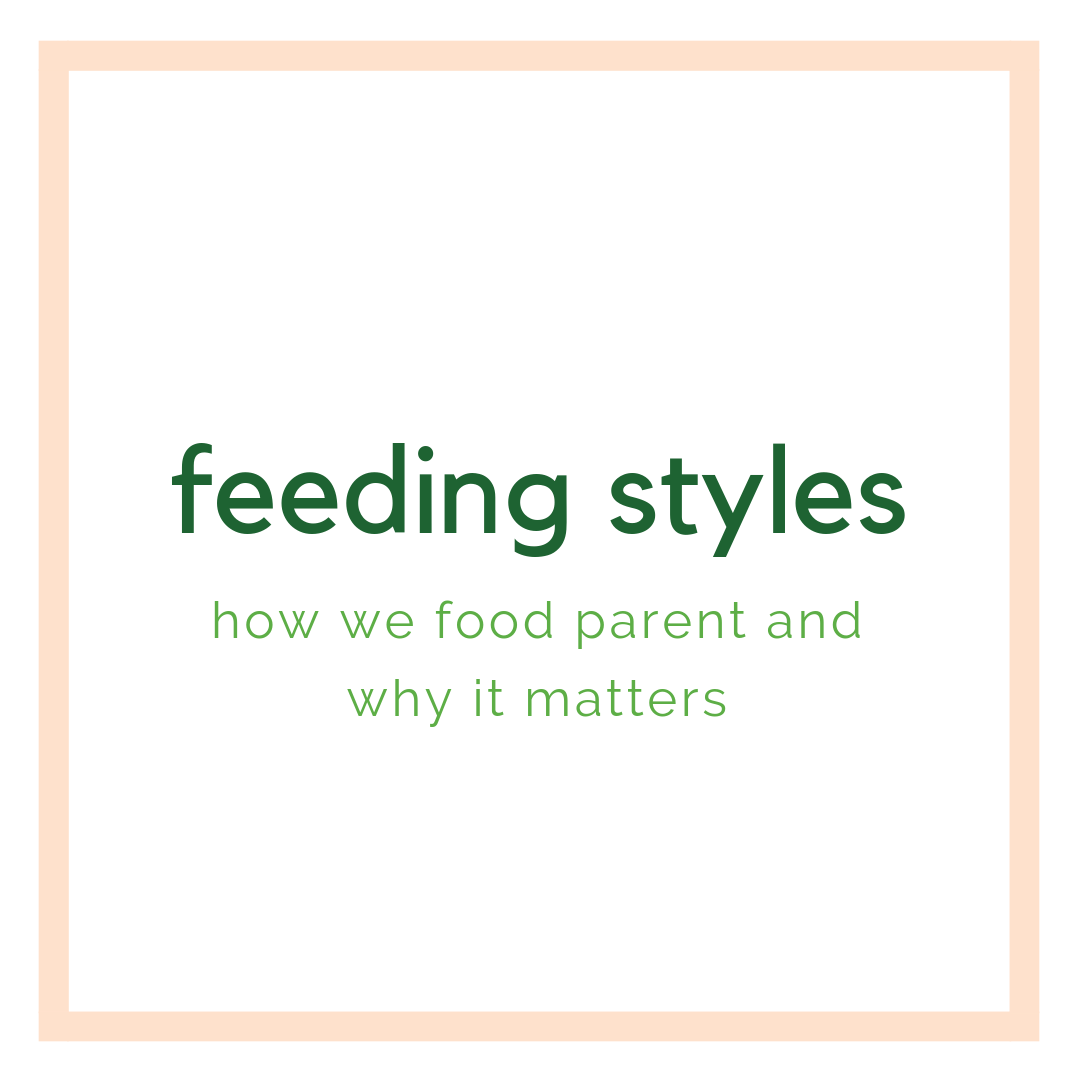Parent Feeding Styles
We all come into parenting with some preset opinions and default attitudes on how we’ll handle things like sleep, car seat safety, diapering, and school. When it comes to food for our kids, our defaults often become our “go-to” parent feeding styles.
“Parent Feeding Styles are defined as “general parent-child interactions across food-related situations””
For example, if as a child, you were raised to be a competent eater, or if you practice intuitive eating as an adult, then you’ll likely always drift back the most effective Authoritative feeding style with your own kids (keeping reading for more on that). In this case, feeding might not be too bad (especially if your children are adventurous eaters to begin with).
But as idyllic as that sounds, it’s not the most common scenario. It’s much more likely for parents to have struggled with their own eating experiences and/or to have to deal with picky eating when it comes to their kids. In these cases, we’re more likely to default to other, less efficient parent feeding styles, based on what’s familiar.
For many of us, drifting back to our “default settings” when it comes to food is something we need to be intentional about avoiding. By learning to practice a new parent feeding style, we can do just that.
What Comes Naturally vs What’s Best
Establishing a good relationship with food does not necessarily mean doing what comes naturally to you. Because it comes most naturally to you, you or your spouse may think you’re “hard wired” to feed and parent just one way. But in fact, the way you feed your kids is made up of a bunch of small, everyday decisions and behaviors. This is great, because it means that you have the ability to change your feeding style if it isn’t working for your family! Of course it also means that you’ll have to put in some work to move from where you are to where you want to be (but it will all be worth it in the end!).
As parents we need to be intentional and consider how certain behaviors in our feeding styles impact our children. If we don’t, we’re leaving them to their own devices when it comes to establishing a healthy relationship with food, and they’re likely to take on our defaults -- for better or for worse.
The Four Parent Feeding Styles
In this article, researchers summarize the two different types of parental feeding strategies presented in the literature: food parenting and feeding styles. Food parenting refers to “specific behaviors or rules parents use to control what, how much, or when their child eats,” whereas parent feeding styles are defined as “general parent-child interactions across food-related situations.”
What’s your parent Feeding Style?
Your parent feeding style is determined by comparing how demanding you are to how responsive you are when it comes to feeding your child. Based on the results of that comparison, you’ll fall into one of 4 feeding styles: Authoritative, Authoritarian, Indulgent (Permissive), or Uninvolved (Neglectful).
Want to know your parent feeding style? I’m going to walk you through the general attitude, the usual approach, and the effect of each style, and give you an example to help you think about what they look like in practice. Consider which style best describes you!
#1 Authoritative
High Demands + High Responsiveness = The “Division of Responsibility” Parent
Attitude: The parent is responsive to the child, puts structure and boundaries in place around meal time, and shows respect for the child’s food choices.
Approach: The parent uses the tactics of trust and choice.
Effect: The child tends to make healthier food choices, have a healthy weight, and practise good self-regulation skills for eating.
Example: The parent actively encourages their child to eat when food is offered, and explains any food rules as needed, in sensitive and supportive ways.
#2 Authoritarian
High Demands + Low Responsiveness = The “Clean Your Plate” Parent
Attitude: The parent tends to show little trust in their child’s food preferences or hunger/fullness signals.
Approach: The parent uses control and tactics like rewards, restrictions, pressure, and prompts to get their children to eat a certain food or a certain amount of food.
Effect: The child tends to have poor appetite regulation and be less likely to eat fruits and vegetables. This style is most often linked to obesity and being overweight.
Example: The parent requires their child to eat certain foods or amounts of food. The rules around the foods offered are not responsive to the child’s hunger, fullness, or food preferences. Instead, they’re parent-centered. This might look like a parent requiring that their child clean their plate before being able to be excused or take a specific number of bites before being allowed to have dessert.
#3 Indulgent (Permissive)
Low Demands + High Responsiveness = The “Yes” Parent
Attitude: The parent tends to allow their child to eat anything, anytime.
Approach: The parent uses tactics like short-order cooking, or allowing their child to graze all day so that their child will eat.
Effect: The child tends to gain too much weight and be out of touch with what and how much to eat. This style is most often linked with a high intake of sweets and high fat foods.
Example: The parent allows their child to decide what, when, and where they eat in order to encourage eating, with very few rules in place. This might look like making whatever their child asks for (on a regular basis), allowing their child to help themselves to any and all snack foods at any time of day, or catering to their child’s food preferences so much so that the child is unable to eat from or accept a meal made for the rest of the family.
#4 Uninvolved (Neglectful)
Low Demands + Low Responsiveness = The “Fly By The Seat of Their Pants” Parent
Attitude: The parent shows low sensitivity to their child’s needs around food and eating.
Approach: The parent fails to plan and prepare food in a regular, reliable manner.
Effect: The child tends to be preoccupied with food. They worry or are anxious about it, causing them to over or under eat. They may also have trust issues with their caregiver.
Example: The parent doesn’t make demands or have meal time routines and responsibilities in place to provide support for child’s needs. This might look like the parent who has erratic and unpredictable patterns in things like grocery shopping, meal planning, and meal preparations, and considers food and feeding to be a very low priority.
Which feeding style do you fall into?
By reviewing these parent feeding styles, my hope is that you can begin to better understand which camp you most often fall into, and how your habitual behaviors in feeding can affect your child. This is a great place to start, especially if you have a goal of changing your family’s current feeding environment.
Remember, change is totally possible! If you want to learn more or get started with a new feeding style, check out the literature (click here and here for interesting studies!), as well as trusted pediatric nutrition resources like Fearless Feeding, which review these styles in more depth (affiliate link).
Work Towards the Authoritative Feeding Style with the Academy!
The Love it, Like it, Learning it® Academy is an 8-week coaching program to teach you the secrets and steps to helping your child learn to like new foods without stress or meal time battles.
Imagine what it would be like if your child:
Was open to try many foods s/he previously wouldn’t touch
Gradually expanded her/his palate to eat from a variety of foods from each food group
Could eat from whatever food was offered to the rest of the family (no more separate meals!)
Learned to like foods s/he previously couldn’t even tolerate on the table
Ate when they were hungry, stopped when they were full, and didn’t throw a fit in between meals and snacks
And imagine if you, as the parent:
Felt less stress and tension at meal times
Were able to address picky eating early on
Finally found an approach to feeding that clicks for you and your child
Felt confident in helping your children become better eaters
Helped your child try different foods without any bribery or pressure






